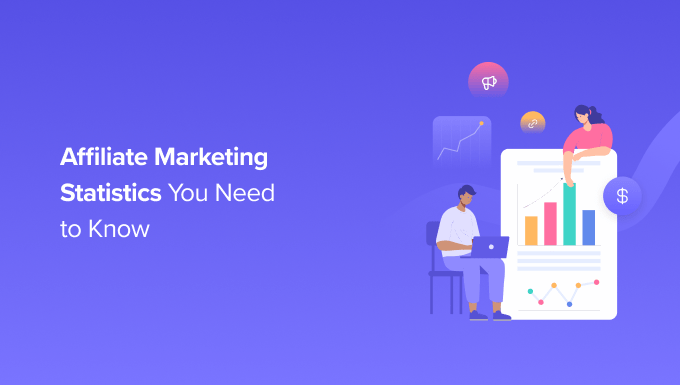Affiliate marketing is super popular and has become an easy way for content creators, businesses, and store owners to earn money online. In fact, we have been using affiliate marketing for over a decade to make money from partnerships on WPBeginner.
However, it is important to look at the latest trends and information before you start selling affiliate products in your own store.
Here at WPBeginner, we have done a lot of research and compiled key data points that highlight the impact of affiliate marketing on businesses, marketers, and social media platforms.
By examining these statistics, you will gain a deeper understanding of current trends, making it easy to launch a solid affiliate marketing strategy for your website.
In this article, take a look at some crucial affiliate marketing statistics that will help you grow your business and generate some money online.

List of Affiliate Marketing Trends and Statistics
We want to make sure you can find the exact affiliate marketing statistics you are looking for, so here are the categories we will explore today.
All you need to do is click on the link that catches your eye, and the page will automatically jump down to the right section:
General Affiliate Marketing Statistics

- The global affiliate marketing industry is worth over $21 billion.
- By 2027, the market size is expected to be worth $27.78 billion.
- Over 80% of digital brands claim to run affiliate programs.
- 40% of merchants go out of their way to find affiliate partners and influencers.
- Experts predict that affiliate marketing will have an annual growth rate of 7.7% between 2025 and 2030.
- Google Trends data shows a steady rise in global searches for “affiliate marketing” since 2016, with a significant increase during the pandemic in 2020 and onwards.
There’s no question that affiliate marketing is growing in popularity and showing no signs of slowing down. The quick growth of this marketing channel proves it is here to stay.
Businesses and marketers will continue to use affiliate marketing to grow their audiences and boost profits in the years to come, and for good reason.
Brand leaders who decide to invest in affiliate marketing strategies find that it helps them drive sales, improve traffic, and generate new leads for their business.
Meanwhile, influencers and solopreneurs have started leaning into affiliate marketing to get more revenue streams. These people are starting blogs and growing social media audiences in order to build their careers and become well-known, successful affiliate marketers.
Affiliate Earnings Statistics

- Affiliate marketing can boost your revenue by 30%.
- Around 10% of affiliate marketers make $73,000+ every year.
- However, 57.5% earn $10,000 or less.
- The average annual income for an affiliate marketer is $54,251.
- 99% of affiliate programs use the CPA (cost per action) payment model. This pays affiliates a commission whenever someone buys something through their affiliate link.
- Almost 49% of merchants pay a flat rate for sales, while the rest pay marketers a percentage based on customer spending.
- 80% of businesses say affiliate marketing has improved their revenue.
- 16% of all online orders come from affiliate links.
Content creators and merchants have a good reason to use affiliate marketing – it earns them a ton of money!
If brands start an affiliate program, their revenue can increase by 30%. This can make them a lot of money because it offers a way to consistently increase profits while boosting brand awareness.
Marketers are also able to earn a decent living by making affiliate sales. 10% of marketers make up to $75k a year, while nearly 60% make under $10k. This statistic isn’t as bad as it seems since most people in this position have multiple revenue streams in place and use affiliate marketing as an extra way to make money blogging.
Plus, there are plenty of ways to make more money from your affiliate links. For instance, you could use OptinMonster to display your affiliate offers in popups, slide-ins, and other campaigns. That way, users are more likely to see and click on your referral links.
Affiliate Marketing Statistics for Merchants

- Affiliate marketing accounts for 16% of all eCommerce sales in America and Canada.
- Businesses report an average return on investment of $15 for every dollar spent.
- On average, businesses use 9% of their digital marketing budget on affiliate marketing partnerships.
- 40% of merchants in the US say affiliate marketing is their main customer acquisition channel.
- Excluding social media, blogs were the top channel used by brands for affiliate marketing, with 28% of businesses using bloggers. Review and coupon affiliate websites were second and third, with 18.7% and 14.8%.
- 81% of businesses say affiliate marketing helps with brand awareness.
- Second only to Google AdSense, affiliate marketing is one of the best ways to boost profits.
- 73% of merchants report being satisfied with their affiliate marketing revenue.
- 49% of brands have affiliate ambassadors to help affiliates maximize sales.
- 83% of shoppers say discounts affect whether they use affiliate links.
- 63% of businesses worry about affiliate marketing fraud within their programs, like unethical marketers using chargebacks and cookie stuffing to artificially inflate sales.
- Businesses lost $1.4 billion in revenue due to affiliate fraud in 2020.
The statistics show that affiliate marketing is an excellent way for companies to expand their reach and dramatically boost sales. With an average return on investment (ROI) of 1,500%, it’s no wonder that this strategy is quickly increasing in popularity.
This figure also explains why most merchants are happy with the revenue they earn from affiliate partnerships.
It’s worth mentioning that companies that work closely with affiliates see better results. This is because brand ambassadors can steer new partners in the right direction, which improves their chances of success.
Despite the benefits, many merchants worry about fraud in the affiliate marketing space. This concern is valid because nearly 30% of brands report experiencing fraud in the form of chargebacks and other types of false or misleading sales.
If you are considering starting an affiliate marketing program, it’s important to have an affiliate management system that meets your needs.
AffiliateWP is an excellent solution that can help you easily track affiliate links, manage creatives for your affiliate marketing campaigns, set up commission rates, and more, all from an easy-to-use dashboard. The best part is you get to keep all your earnings, which means you can grow without paying additional fees.
Affiliate Marketer Statistics and Demographics

- Almost 15% of affiliate marketers say finding brand deals is their biggest pain point.
- On average, affiliate marketing has a conversion rate of .5% to 1%.
- Experienced marketers (3 years or more) report making 9.45% more than newer ones.
- 41.9% of marketers with over 10 years of experience say email is their main traffic source.
- Meanwhile, US affiliates say their blog helps them generate 40% of their income.
- 28% of affiliate publishers create blog posts to promote affiliate links.
- 73% of marketers say they would rather join an in-house affiliate program as opposed to an affiliate network.
- The average affiliate marketer promotes between 1-10 products at a time.
- 77% of affiliates report working alone.
- 83% of marketers are optimistic about the future of affiliate marketing.
Affiliate associates can also make money and build their reputations through affiliate marketing.
Content creators combine content marketing strategies like blogging, email, and social media marketing to create unique experiences for their audiences. They typically partner with brands that offer products their audiences may like.
You can see common examples of this in practice on recipe blogs. The author will typically include the tools used in the recipe throughout the post. For instance, you could link to a pasta strainer, mixer, or set of bowls offered by one of their partners.
When someone lands on your site to read a recipe, there’s a chance they will click on equipment suggestions and place an order. You would then earn an affiliate commission on what was sold.
If you are considering trying this strategy but are worried about going back through your old posts and adding links, you will need a tool like Tasty Links. This plugin lets marketers automatically add links to specific keywords.
So, in this case, you could type in “pasta strainer” and turn all the mentions of that phrase on your blog into clickable affiliate links.
Related: See our tutorial on how to add an affiliate disclosure for each blog post automatically.
Social Media Statistics

- Social media is the second-best traffic source for affiliate marketers (67.9%).
- 4.62 billion people use social media sites every month.
- The average content creator uses 3 or more social channels to promote affiliate products.
- 67.3% of affiliate marketers use social media to connect with shoppers.
- 74% of social media influencers use affiliate marketing to increase their earnings.
- This strategy clearly pays off because users tap 130 million sponsored posts on Instagram each month.
- The top three social media channels for affiliate marketing are Facebook (75.8%), Instagram (61.4%), and Pinterest (42.4%).
- 19.3% of affiliates say shareable social media videos, like those on YouTube and TikTok, help them promote products and services.
- 88% of online shoppers have been convinced to buy something by an influencer.
- This aligns with the fact that 9 out of 10 shoppers say reviews directly impact their shopping habits and purchasing decisions.
- Brands pay Instagram influencers between $100 – $2,085 for every post. This figure is calculated based on the type of promotion and the follower count.
It is almost impossible to discuss affiliate marketing without including social media. Sites like Instagram, Facebook, YouTube, and Pinterest are great places to boost engagement and build trust between businesses and affiliate partners.
This is one of the main reasons social sites are the second-best traffic sources for affiliate marketers.
From a merchant’s perspective, social media reviews and engagement from content creators are excellent ways to build social proof. Most people want to see reviews, unboxings, and other types of user-generated content before they place an order.
You can easily leverage the power of social proof from Instagram and Facebook on your website by adding a social media feed with Smash Balloon. This handy social media tool allows you to show users what’s happening on social media in real time while they are browsing your site.
Whether you are a business owner or a marketer, it’s important to keep affiliate links short and sweet. Long links can overwhelm and confuse people, which may push them to head away from your site. Using Pretty Links is the ideal way to make links more attractive on social media, which means more clicks and engagement.
SEO Statistics

- 78% of affiliate marketers say SEO helps them get more organic traffic.
- Around 70% of all affiliate traffic comes from SEO.
- This makes sense when you consider that over 53% of people use search engines when they want to shop online but don’t know where to start.
- Google searches with the words “affiliate marketing” have increased 4X since 2020.
Search engine optimization (SEO) and affiliate marketing are two totally different strategies, but they complement each other in interesting and valuable ways.
A business with a strong affiliate program is more likely to build backlinks. Google sees backlinks from reputable sites as a seal of approval. If high-profile influencers and content creators are linking to your site, then there’s a good chance your website will go up in the search rankings.
This strategy can be very helpful for businesses trying to reach the elusive top 10 spot for their chosen keywords. Over 66% of pages on the internet don’t have a single backlink, which is why many sites struggle to rank.
Affiliate marketers can boost their search positions and organic traffic through these partnerships. You can even use a tool like All in One SEO (AIOSEO) to generate affiliate link reports.
These reports help creators determine which products get the most clicks. In turn, this can help you streamline your affiliate strategy and make smart decisions when choosing your next partners.
Engagement Statistics

- 38% of marketers say affiliate marketing is the best way to boost leads and generate sales.
- 79% of marketing experts say affiliate marketing boosts engagement by helping them connect with existing customers.
- 60% of business leaders say affiliate marketing has helped them convert leads into customers.
- Affiliate links get over 5 billion clicks each year.
- Using email marketing to promote affiliate products can help you earn 66.4% more than people who don’t build an engaged email list.
Engagement is a major benefit of affiliate marketing for brands and content creators alike.
Working with affiliates can help businesses strengthen relationships with existing customers, generate new leads, and boost sales.
At the same time, affiliate marketers can grow their leads and better understand their target audience by tracking engagement and taking action based on what they learn.
For example, if one section of your WordPress website sees more engagement than the rest, then you can use this information to shape your strategy. You could even work with relevant figures in the industry that is most popular with your visitors.
We recommend using an analytics tool like MonsterInsights to track user engagement on your website. That way, you will be better equipped to understand your affiliate marketing data and improve your strategy.
Niche-Specific Affiliate Statistics

- eLearning, travel, and beauty are the three most popular affiliate marketing niches.
- Retail accounts for 76% of all affiliate spending in the United States.
- 25% of all affiliate programs are in the fashion industry.
- Affiliate marketing sales in the home and garden industry increased by over 209% last year, making it the fastest-growing industry
- The SaaS industry offers the highest commission rate. You expect to earn between 20-70% for each sale.
- The health and wellness industries are the most profitable niche, worth over $5.5 trillion.
- The affiliate marketing software industry made over $216 million between 2020 and 2022.
Understanding unique niches will help you make informed choices when picking your affiliate partners. As you can see above, the SaaS industry has quickly become one of the best affiliate niches to get involved in because of its unusually high commission rates.
However, if you are not into promoting software, then there are some options to offer physical goods to your audience. For instance, people are more interested in eLearning, gardening, and cooking than ever before.
If you choose products and niches that you are generally interested in, then your passion will show in your work, and your readers will trust in your content.
For more tips, see our guide on how to build trust with ethical affiliate marketing.
Amazon Affiliate Statistics

- The largest affiliate marketing program is Amazon Associates, which holds 47.3% of the market share.
- In Q1 of 2023, Amazon earned a staggering $1.28 billion from affiliate sales.
- The Amazon Affiliates program has over 900,000 members.
- Amazon is responsible for 10.4% of all retail sales in the US.
- Amazon is estimated to overtake Walmart in sales by the end of 2024.
We can’t create an article on affiliate marketing statistics without mentioning Amazon. Currently, Amazon Associates owns nearly 50% of the market.
When you consider that they made over $1.25 billion due to affiliate sales during the first three months of 2023, it’s clear why they dominate the industry. For this reason, some creators just focus on creating an Amazon affiliate website.
Amazon Associates is an excellent way to make some extra money promoting products and services you use daily. Their commission rates are generally low, but making a valuable blog with tons of links can help you create a consistent passive income.
If you’re looking for an alternative to Amazon Associates, you can join affiliate marketing networks like ShareASale, CJ Affiliate, Rakuten, and Awin.
List of Sources
WPBeginner, AffiliateWP, OptinMonster, TrustPulse, MemberPress, Smash Balloon, RafflePress, WPForms, Blogging Wizard, Finances Online, Influencer Marketing Hub, Forbes, Authority Hacker, Demandsage, Business2Community, LinkedIn, Statista
We hope this list of affiliate marketing statistics, trends, and facts will help you improve your marketing efforts as a business owner or increase your sales as an affiliate marketer. You may also want to see our other research articles:
Best Statistics, Trends, and Research Articles
- Influencer Marketing Statistics You Should Know
- 70+ Shopping Cart Abandonment Statistics (Expert Insights)
- Blogging Statistics, Trends & Data – Ultimate List
- Creator Economy Statistics That Will Blow You Away
- 60+ Internet Usage Statistics and Latest Trends
- 100+ Surprising Customer Service Statistics and Trends
If you liked this article, then please subscribe to our YouTube Channel for WordPress video tutorials. You can also find us on Twitter and Facebook.





Dennis Muthomi
The projection that the affiliate marketing industry will be worth $27.78 billion by 2027 highlights the incredible growth and profit potential of affiliate marketing as a business model.
With high ROI for businesses and the ability to leverage platforms like social media and SEO, it’s no wonder that affiliate marketing is thriving and presents a lucrative opportunity.
Jiří Vaněk
I observe this in my surroundings as well. Many people around me who are involved in online businesses are now focusing on either affiliate marketing or dropshipping. Both allow for quite interesting profits without the need to have warehouses or inventory. You simply resell and collect the profit, which is an intriguing way to earn if you can attract people and create appealing advertisements for the products through social media or, for example, YouTube. It is definitely interesting to watch.
Mrteesurez
Great article, as an affiliate marketer , the information is useful in determining which products to promote, which industry and some other information to strategize marketing.
I will be starting my affiliate marketing website soon, this guide keeps me motivated.
I have also noticed the fact that Saas industry offers the highest affiliate commission rate starting from web hosting and email services to WP themes and plugins shops, and yes majority of them pay in percentage.
Thanks for sharing these information, it’s really helpful to me.
Moinuddin Waheed
To do well in affiliate marketing, I think choosing the right niche play very important role.
I agree with your opinion mrteesurez that saas industry gives very handsome amounts as affiliate commission to its partners. Being in the field of writing for blogs, I can witness this fact from very close.
Nevertheless, any niche can give good returns if persued well.
Kamorudeen Ganiyat
How do I register for affliate marketing
WPBeginner Support
You would need to have a live site somewhere and then it would depend on the specific product for the requirements to join their program
Admin
Jiří Vaněk
Interesting statistics when you see them in one place like this. I started with the Internet on an old modem and experienced an era when the Internet was just starting and there was no wifi. It is interesting to see how the online world is developing from a business point of view.
Konrad
Enjoying the statistical deep dives, always intriguing. Great read
WPBeginner Support
Glad you liked it
Admin
Ernest
Thank for this again♥️
WPBeginner Support
You’re welcome
Admin
Ahmed Omar
the post is really helpful regarding the affiliate programs
I am just recently joined one of the affiliate program and I found that improving the SEO score, improve the visitors numbers and also the income
I will consider SEO one of the important points for any site
Thank you
WPBeginner Support
You’re welcome
Admin
Ralph
This is really important information for me. I am earning okayish money with affiliate marketing in my country but I plan to open website for the entire world and those stats definitely gave me more hope in what I’m doing to earn a living.